Science Museum, London
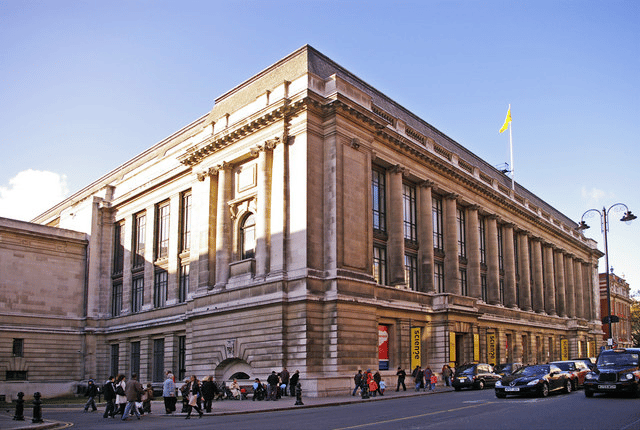
Science Museum, London

| Established | 1857 (1857) (separate status formalised 1909) |
|---|---|
| Location | Exhibition Road, Kensington & Chelsea London, SW7 United Kingdom |
| Coordinates | 51°29′51″N 0°10′29″W [38] |
| Visitors | 3,174,963 (2018)[1]
|
| Director | Ian Blatchford |
| Public transit access | South Kensington |
| Website | sciencemuseum.org.uk [39] |
| Science Museum Group | |
| |
The Science Museum is a major museum on Exhibition Road in South Kensington, London. It was founded in 1857 and today is one of the city's major tourist attractions, attracting 3.3 million visitors annually.[2]
Like other publicly funded national museums in the United Kingdom, the Science Museum does not charge visitors for admission. Temporary exhibitions, however, may incur an admission fee. It is part of the Science Museum Group, having merged with the Museum of Science and Industry in Manchester in 2012.
| Established | 1857 (1857) (separate status formalised 1909) |
|---|---|
| Location | Exhibition Road, Kensington & Chelsea London, SW7 United Kingdom |
| Coordinates | 51°29′51″N 0°10′29″W [38] |
| Visitors | 3,174,963 (2018)[1]
|
| Director | Ian Blatchford |
| Public transit access | South Kensington |
| Website | sciencemuseum.org.uk [39] |
| Science Museum Group | |
| |
Origin and history
The museum was founded in 1857 under Bennet Woodcroft from the collection of the Royal Society of Arts and surplus items from the Great Exhibition as part of the South Kensington Museum, together with what is now the Victoria and Albert Museum. It included a collection of machinery which became the Museum of Patents in 1858, and the Patent Office Museum in 1863. This collection contained many of the most famous exhibits of what is now the Science Museum.
In 1883, the contents of the Patent Office Museum were transferred to the South Kensington Museum. In 1885, the Science Collections were renamed the Science Museum and in 1893 a separate director was appointed.[3] The Art Collections were renamed the Art Museum, which eventually became the Victoria and Albert Museum.
When Queen Victoria laid the foundation stone for the new building for the Art Museum, she stipulated that the museum be renamed after herself and her late husband. This was initially applied to the whole museum, but when that new building finally opened ten years later, the title was confined to the Art Collections and the Science Collections had to be divorced from it.[4] On 26 June 1909 the Science Museum, as an independent entity, came into existence.[4]
The Science Museum's present quarters, designed by Sir Richard Allison, were opened to the public in stages over the period 1919–28.[5] This building was known as the East Block, construction of which began in 1913 and temporarily halted by World War I. As the name suggests it was intended to be the first building of a much larger project, which was never realized.[6] However, the Museum buildings were expanded over the following years; a pioneering Children's Gallery with interactive exhibits opened in 1931,[4] the Centre Block was completed in 1961-3, the infill of the East Block and the construction of the Lower & Upper Wellcome Galleries in 1980, and the construction of the Wellcome Wing in 2000 result in the Museum now extending to Queen's Gate.
Collections
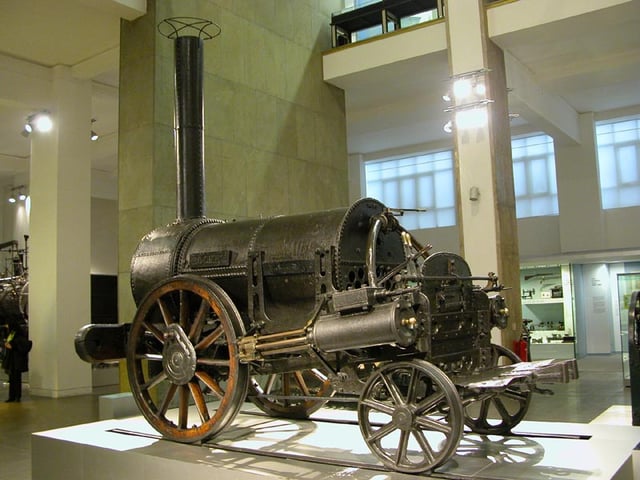
Stephenson's Rocket.
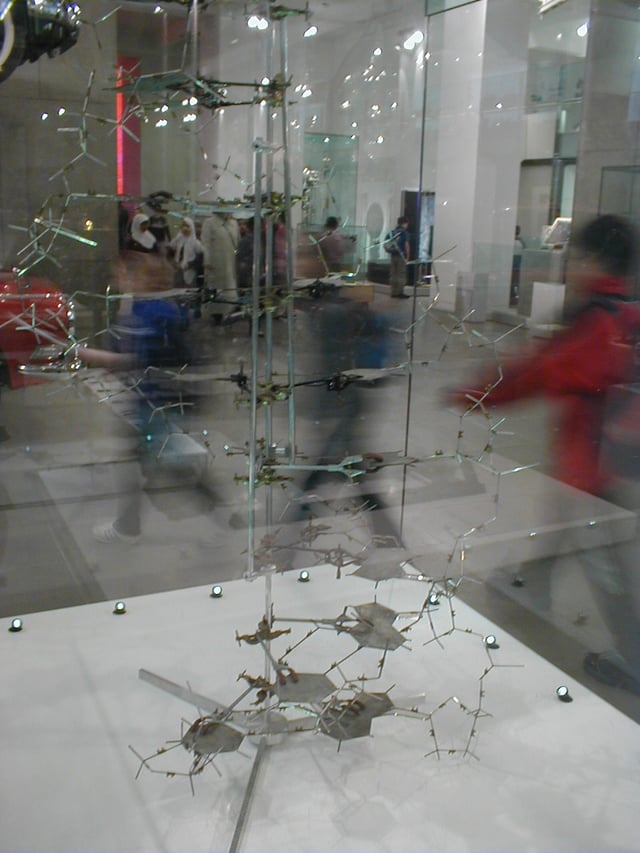
Replica of the DNA model built by Crick and Watson in 1953.
The Science Museum now holds a collection of over 300,000 items, including such famous items as Stephenson's Rocket, Puffing Billy (the oldest surviving steam locomotive), the first jet engine, the Apollo 10 command module, a reconstruction of Francis Crick and James Watson's model of DNA, some of the earliest remaining steam engines (Including an example of a Newcomen steam engine, the world’s first steam engine), a working example of Charles Babbage's Difference engine, the first prototype of the 10,000-year Clock of the Long Now, and documentation of the first typewriter. It also contains hundreds of interactive exhibits. A recent addition is the IMAX 3D Cinema showing science and nature documentaries, most of them in 3-D, and the Wellcome Wing which focuses on digital technology.[7] Entrance has been free since 1 December 2001.
The museum houses some of the many objects collected by Henry Wellcome around a medical theme. The fourth floor exhibit is called "Glimpses of Medical History", with reconstructions and dioramas of the history of practised medicine. The fifth floor gallery is called "Science and the Art of Medicine", with exhibits of medical instruments and practices from ancient days and from many countries. The collection is strong in clinical medicine, biosciences and public health. The museum is a member of the London Museums of Health & Medicine.
The Science Museum has a dedicated library, and until the 1960s was Britain's National Library for Science, Medicine and Technology. It holds runs of periodicals, early books and manuscripts, and is used by scholars worldwide. It was, for a number of years, run in conjunction with the Library of Imperial College, but in 2007 the Library was divided over two sites. Histories of science and biographies of scientists were kept at the Imperial College Library in London until February 2014 when the arrangement was terminated, the shelves were cleared and the books and journals shipped out, joining the rest of the collection, which includes original scientific works and archives, in Wroughton, Wiltshire.[8] The Imperial College library catalogue search system now informs searchers that volumes formerly held there are "Available at Science Museum Library Swindon Currently unavailable". A new Research Centre with library facilities is promised for late 2015 but is unlikely to have book stacks nearby.
The Science Museum's medical collections have a global scope and coverage. Strengths include Clinical Medicine, Biosciences and Public Health. The new Wellcome Wing, with its focus on Bioscience, makes the Museum a leading world centre for the presentation of contemporary science to the public.
As of 2019 170,000 items which are not on current display are stored at Blythe House in West Kensington, in addition to storage at the Science Museum at Wroughton, a 220-hectare (545-acre) former RAF base near Swindon owned by the Museum since 1979. Blythe House storage is shared with the British Museum and the Victoria and Albert Museum, and also houses facilities including a conservation laboratory, a photographic studio, and a quarantine area where newly arrived items are examined.[9]
The museums have to move out of Blythe House. The Science Museum will use £40m from the government to develop the Wroughton site and put many previously stored items on display there from 2023, in addition to storage, conservation labs, and research facilities.[10]
The Dana Centre
In November 2003, the Science Museum opened the Dana Centre. The centre is an urban bar and café annexed to the museum. It was designed by MJP Architects.[11]
In October 2007, the Science Museum cancelled a talk by the co-discoverer of the structure of DNA, James D. Watson, because he claimed that IQ test results showed blacks to have lower intelligence than whites. The decision was criticised by some scientists, including Richard Dawkins,[12] as well as supported by other scientists, including Steven Rose.[13]
Informal Learning
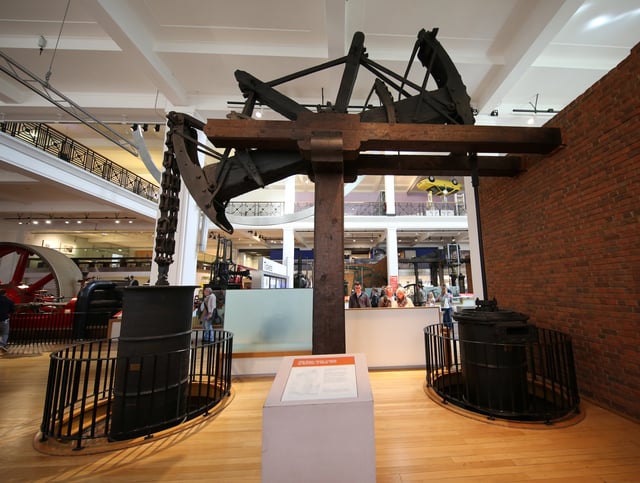
Old Bess, A surviving example of a steam engine made by James Watt, in 1777.
Around 450,000 young people visit the Science Museum on educational trips or benefit from its outreach programmes each year, more than any other UK museum.[14]
Science Night
The Science Museum also organises "Science Night", "all-night extravaganza with a scientific twist". Up to 380 children aged between 8 and 11, accompanied by adults, are invited to spend an evening performing fun "science based" activities and then spend the night sleeping in the museum galleries amongst the exhibits. In the morning, they're woken to breakfast and more science, watching a film before the end of the event.[15]
Lates
On the evening of the last Wednesday of every month (except December) the museum organises an adults only evening with up to 30 events, from lectures to silent discos. Previous Lates have seen conversations with the actress activist Lily Cole[16] and Biorevolutions with the Francis Crick Institute which attracted around 7000 people, mostly under the age of 35.[17]
Galleries

The East Hall
The Science Museum is made up of a number of galleries, some of which are permanent, and some of which are temporary.
Power: The East Hall

Video of a Corliss steam engine in the Power Gallery in motion.
The East Hall is the first area that most visitors see as they enter the building, stretching up through three floors. On the ground, the area is mostly filled with iconic steam engines of various sorts, including the oldest surviving James Watt beam engine, which together tell the story of the British industrial revolution. Up in the air, suspended from the ceiling is a giant metallic ring, the inside of which is covered in white LEDs which form patterns and display messages typed into kiosks by visitors in the Energy gallery.
Also on display is a recreation of James Watt's garret workshop from his home, Heathfield Hall, using over 8,300 objects removed from the room, which was sealed after his 1819 death, when the hall was demolished in 1927.[18]
Exploring Space
Exploring Space is a historical gallery, filled with rockets and exhibits that tell the story of human space exploration and the benefits that space exploration has brought us (particularly in the world of telecommunications).
Making the Modern World
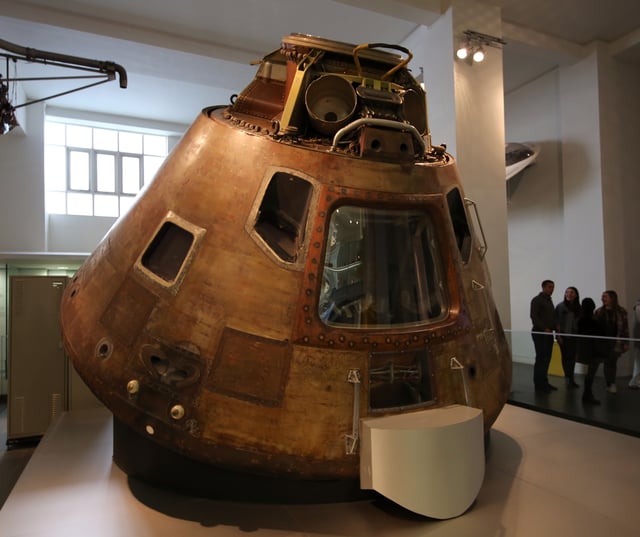
The Apollo 10 Command Module Charlie Brown, which orbited the Moon 31 times in 1969,[19] is displayed in the Modern World Gallery
Making the Modern World is a relatively new gallery, in which some of the museum's most iconic objects, including Stephenson's Rocket, Watson and Crick's double helix, and the Apollo 10 command module are displayed along a timeline chronicling man's technological achievements.
Flight
Flight is another longstanding gallery, up towards the western end of the third floor. Contained in the gallery are several full sized aeroplanes and helicopters, including Alcock and Brown's transatlantic Vickers Vimy (1919), Spitfire and Hurricane fighters, as well as numerous aero-engines and a cross-section of a Boeing 747.
Launchpad
One of the most popular galleries in the museum is the interactive Launchpad gallery. Redesigned and reopened in November 2007, the new look gallery houses over 50 interactive exhibits illustrating many different concepts in physical science. The gallery is staffed by Explainers who are available to demonstrate how exhibits work, conduct live experiments and perform shows to schools and the visiting public. Launchpad has now closed [40] ,[20] the Science Museum are preparing a new Interactive gallery [41] which opens in late 2016. The new gallery will be bigger than Launchpad and packed with state-of-the-art interactive exhibits.
Media Space
This gallery is a collaboration between the Science Museum and the National Science and Media Museum in Bradford, home of a photography collection of more than three million images.[21]
Information Age
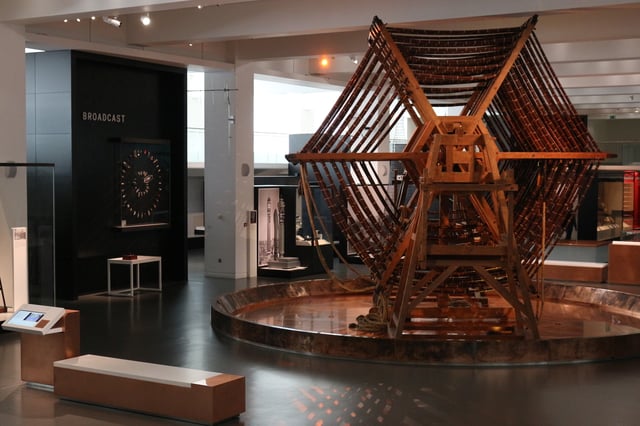
Information Age Gallery at the Science Museum London
The landmark gallery explores the six networks that have transformed global communications: The Cable, The Telephone Exchange, Broadcast, The Constellation, The Cell and The Web/[22]
It was opened on 24 October 2014 by the Queen, Elizabeth II, who sent her first tweet.[23] It replaced the former Shipping galleries, on the second floor, which closed on 15 May 2012. Their contents were 3D scanned and made available online.[24]
Engineer your Future
This gallery opened in December 2014, and aims to inspire school children to go into careers in engineering. It was developed with a consortium of companies and the Royal Academy of Engineering.[25]
Medicine Galleries
A suite of five permanent galleries dedicated to the history of medicine is due to open in the Autumn of 2019.[26] The galleries will be based on the collections of Henry Wellcome and the Science Museum [42] . The permanent collection “Being Human” has design and content tailored to the needs of disabled people. [27]
Temporary exhibitions
These range from the award-winning Codebreaker, on the life of Alan Turing,[28] to Unlocking Lovelock, which explores the archive of James Lovelock.[29]
Touring exhibitions
The Science Museum has developed many touring exhibitions over the years. The Science Box contemporary science series toured various venues in the UK and Europe in the 1990s and from 1995 The Science of Sport appeared in various incarnations and venues around the World. In 2005 The Science Museum teamed up with Fleming Media to set up The Science of... who develop and tour exhibitions including The Science of Aliens, The Science of Spying and The Science of Survival
In 2008, The Science of Survival exhibition opened to the public and allowed visitors to explore what the world might be like in 2050 and how humankind will meet the challenges of climate change and energy shortages.
In 2014 the museum launched the family science Energy Show, which toured the country.[30]
The same year it began a new programme of touring exhibitions which opened with Collider: Step inside the world’s greatest experiment to much critical acclaim. The exhibition takes visitors behind the scenes at CERN and explores the science and engineering behind the discovery of the Higgs Boson. The exhibition will tour until early 2017.
Media Space exhibitions also go on tour, notably Only in England which displays works by the great photographers Tony Ray-Jones and Martin Parr.
Location
The museum is adjacent to the Natural History Museum and used to be connected to it by a public corridor, which is now closed. The closest London Underground station is South Kensington; a subway connects the museums to the station.
At the front of the museum to the east is Exhibition Road. Immediately to the south is Museum Lane and the Natural History Museum. To the rear is Queen's Gate and to the north is Imperial College.
Refurbishment
The Science Museum underwent a series of refurbishments as part of a vision to update the museum. The East Hall has been finished and the renovated museum shop opened in October 2005.
Online
The Science Museum's website has a variety of features, including collections information and the award-winning Launchball game.[31]
Environment
The museum joined the 10:10 project in 2009 in a bid to reduce its carbon footprint. One year later it announced that it had reduced its carbon emissions (according to 10:10's criteria) by 17%.[32]
Centennial volume: Science for the Nation
The leading academic publisher Palgrave Macmillan published the official centenary history of the Science Museum on 14 April 2010. The first complete history of the Science Museum since 1957, Science for the Nation: Perspectives on the History of the Science Museum is a series of individual views by Science Museum staff and external academic historians of different aspects of the Science Museum's history. While it is not a chronological history in the conventional sense, the first five chapters cover the history of the museum from the Brompton Boilers in the 1860s to the opening of the Wellcome Wing in 2000. The remaining eight chapters cover a variety of themes concerning the Museum's development.
Directors of the Science Museum

Making the Modern World gallery from above
The Directors of the South Kensington Museum were:
Henry Cole CB (1857–1873)
Sir Philip Cunliffe-Owen KCB KCMG CIE (1873–1893)
The Directors of the Science Museum have been:
Major-General Edward R. Festing CB FRS (1893–1904)
William I. Last (1904–1911)
Sir Francis Grant Ogilvie CB (1911–1920)
Colonel Sir Henry Lyons FRS (1920–1934)
Colonel E. E. B. Mackintosh DSO (1933–1945)
Dr Herman Shaw (1945–1950)
Dr F. Sherwood Taylor (1950–1956)
Sir Terence Morrison-Scott DSc FMA (1956–1960)
Sir David Follett FMA (1960–1973)
Dame Margaret Weston DBE FMA (1973–1986)
Sir Neil Cossons OBE FSA FMA (1986–2000)
Dr Lindsay Sharp (2000–2002)
Ian Blatchford (2010–)
The following have been Head/Director of the Science Museum in London, not including its satellite museums:
Jon Tucker[33] (2002–2007, Head)
Prof. Chris Rapley CBE (2007–2010)
The following have been Directors of the National Museum of Science and Industry, (since April 2012 renamed the Science Museum Group) which oversees the Science Museum and other related museums, from 2002:
Dr Lindsay Sharp (2002–2005)
Jon Tucker (2005–06, Acting Director)
Prof. Martin Earwicker FREng (2006–2009)
Molly Jackson (2009)
Andrew Scott CBE (2009–10)
Ian Blatchford (2010–)
